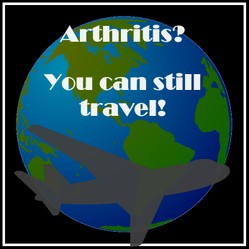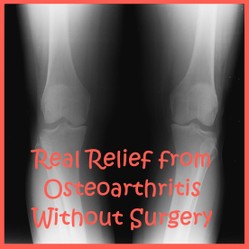I suffered knees injuries in both knees from a ski accident when I was 12. After the age of 30, I began to suffer in cold and wet weather and sometimes the pain would almost knock me out. But the doctors did not offer any solutions nor seem much perturbed by it. By the time I was 45, I was stiffening up after sitting for long stretches and I would wake up almost immobile in the mornings, hobbling along until my body would warm up. At this point, I was diagnosed with osteoarthritis and given a knee brace and told to take pain medication and that's it!
By my mid 50s I was starting to do less - could no longer dance, run, or walk for long distances. I was told I was a candidate for knee replacement surgery, but to delay it as long as possible since there are new improvements all the time. I still travelled freely, taking lots of pain meds with me and doing much less than I was used to doing.
I even went woofing (working as a volunteer on an organic farm) after telling my host that I was 60 and had stiff knees. He was not put off by that and I ended up quite good at grazing the sheep and goats (lots of time to rest).
Suddenly last summer, my arthritis got so bad that I could barely stand or move. Travel seemed a thing of the past. Then I heard of APOStherapy (see below) and it saved my life - without surgery, I am back to a reasonable level of functioning. I no longer take pain medication every day, but I have to be careful how much walking I do each day so as not to be unable to move the next day. I only occasionally get stiff knees when sitting for long times, but I still cannot dance.
Everyone is different and you use what you know about yourself to make your travel do-able and enjoyable.








 Visiting an Art Gallery With a Two-Year-Oldon 07/27/2015
Visiting an Art Gallery With a Two-Year-Oldon 07/27/2015
 Using the News to Enhance Jewish Identity in Jewish Kidson 07/24/2015
Using the News to Enhance Jewish Identity in Jewish Kidson 07/24/2015
 Xi'an - Not Just Terracotta Warriorson 06/09/2015
Xi'an - Not Just Terracotta Warriorson 06/09/2015
 Sew Your Own Wedding Dress - or Your Daughter'son 02/06/2015
Sew Your Own Wedding Dress - or Your Daughter'son 02/06/2015



Comments
I am much better these days, WriterArtist, but I can have bad days like this where after a meal at a restaurant, I hobble out the door until the joints get loosened up again. Yes, I think when we share our stories we feel less handicapped by the difficulties and perhaps a bit more adventuresome.
I need to be careful while traveling because my joints freeze if I don't move for couple of hours.
I only travel when I am okay and equipped with my medicines and ayurvedic oil for massaging joint pains. I remind myself that I have to get up every couple of hours to exercise my hands and limbs. You have brought up an interesting article as we all are becoming aware of this disease becoming increasingly present in more and more people.
There are probably differences in how rheumatoid and osteo-arthritis are experienced, among other variables that influence people differently. My arthritis is purely my own initiative (can't blame genes for it) because of a childhood sports injury. At least I don't have to worry that my kids will be like me when they get older. Small mercies.
I thought I'd founded that club, Frank. Oh well, just goes to show. Sheri, I am beginning to see that arthritis and rheumatism are a very complex group of painful problems, triggers to each person's suffering vary and we all learn to cope in different ways. I find that if I sit still for too long my knees simply lock, which ratchets the pain index into throbbing agony and clicky joints that others can hear when I do get up. However, if I sit for an hour or so then walk for five minutes, then sit again, the pain on moving is less. I have associated medical issues in my family, a long history of arthritis, rheumatism and digestive disorders which manifest as circulatory irritation including joint inflamation.
Sitting is very bad for stiffening the knees. I suffer a problem related to arthritis, anterior knee pain, which is felt round the edges of the kneecap. It is not arthritis, but it is felt when I rise from a chair or descend stairs. Walking is the best defence. but I need to lose some weight, but this is proving hard.
Thanks, WordChazer. I find (with full-blown arthritis), getting up and walking around only means I suffer several times with stiff knees and not just at the end of the flight. Yes, standing in place is far worse than walking. But if I walk too fast (what used to be my normal pace), I suffer the next day. Isn't it interesting how everyone can experience the same kind of thing differently!
I agree that arthritis should not be declared when getting travel insurance. It is not likely to cause any need for medical care when traveling, anyway!
As someone with stiff joints (and potential arthritis in later life) I find that getting up and walking regularly when on a long flight or drive helps. We often road trip as a foursome with our friends, who drink a lot of water, so need regular compfrt breaks. That helps me too, as not only do I drink a lot of fluid, I then find that I do need comfort breaks too.
Flights are easier when I have more legroom, but unfortunately the level of coach to allow me a footrest or footstool is beyond my budget, so walking laps around the airplane to kick start my circulation is the only way. Unless your arthritis is such that you need a wheelchair, I would advise against declaring it in travel insurance, because the companies will double the price and then blink.
If I'm travelling in the UK by road, and know that the destination will mean a lot of walking, I have a cane. Otherwise my husband is well trained to having one shoulder pulled out of line when I lean on him and hobble at my worst. I walk better at speed, and nothing makes me hurt more than having to move at millimetres-per-hour in crowds or lines.
Last night, when reading, I discovered that nettle tea is a palliative for arthritis. Use the leaves of young nettles, preferably the small ones at the top, and boil them in water, then drink the resulting tea. The sting disappears in hot water. Old nettle leaves contain oxalic acid and should not be used. Nettles' value comes the fact that' they are very rich in mineral salts, because their roots stretch deep into the subsoil and draw up minerals.
Not only nettles, but white dead nettle, which has no sting, is good for arthritis.
Omega-3 is something I do, too, for my back. Didn't think of food allergens though, as I don't have allergies. But maybe those are best avoided during travels no matter what, especially as the body is exposed to new allergens.
Thanks, Frank. Apple vinegar and honey is wonderful against inflammation. However, there sometimes comes a point when such remedies no longer work. For some people it may be enough to stave off the ravages of osteosarthritis, but for others it is not.